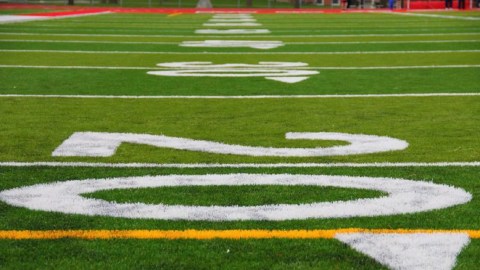What Does Football Really Teach Us?

Football replaced baseball as the “national pastime” long ago (despite some arguments to the contrary). The hoopla surrounding the upcoming secular American holiday of Super Bowl XLIX Sunday testifies conclusively to that fact. The trickle down effect of that passion inspires younger and younger people to put on the pads and crash into one another as well as make parents shuttle their charges to practices and games and witness the conflict—all in the name of football’s educational benefits of perseverance, courage, and teamwork. But what does football really teach us? In Why Football Matters: My Education in the Game, author Mark Edmundson recounts his own high school football experience from the perspective of age and asks that very same question in a nuanced, clear-eyed way that might make you think twice about why we love football so much and what that love may be doing to us and our children.
Edmundson, an English professor at the University of Virginia specializing in 19th century American and British literature, recounts his personal evolution from soft, unathletic, near-sighted 1960s small-town teen into varsity player on the high school football team with equal parts self-deprecation and affection for his youthful self (a photo of whom graces the cover of the book). Once a coach yells at him to “run through” his pads rather than to let them weigh him down, Edmundson discovers previously untapped reserves of strength and persistence that make him not just a serviceable player, but also a much better student than before. This “blindbacker” (the nickname the myopic linebacker earns for refusing to wear his glasses while playing, sometimes resulting in him tackling his own teammates) finds his eyes opened by the possibilities of the game.
However, the older Edmundson looks back and sees a darker side to that football education as well. Although Edmundson agrees that football “can be a superb school for body, heart, and mind,” he compels us “to see how much harm football can do, and not just to the body.” For the author, “Football is a potentially ennobling, potentially toxic school for the spirit. When you play the game seriously, you put your soul on the line.” For all the character building of the sport, “[b]rutality, thoughtlessness, dull conformity, love for the herd mentality and the herd—these can be products of football too.”
Edmundson weighs the good and bad of football with startling clarity: “We pay for our sins, to be sure. But even for our virtues there is sometimes a price. I think that everyone who has learned courage from football has got to recognize what it may cost, no matter what the coaches and the boosters say. Character costs something; courage can come with a price.” Those looking for a rah-rah cheerleader or a sidelines condemner will both come away disappointed. Instead, Edmundson philosophically calls for moderation in our love for football (or similar pursuits) and what we hope to learn from it. “If education by football (or basketball or rap) is the only education that’s available to you, or the only kind you can respond to,” Edmundson counsels, “you may be in a bad way.” Knowing from firsthand experience that the “guts” one gains from the gridiron “can change into vainglory, aggression, and bullying,” Edmundson hopes to save others from that same miseducation.
Why Football Matters will surprise many readers hoping for a simple sports yarn with Edmundson’s range. When the reader reaches the point where Edmundson tries to illustrate the dichotomy of imagination and individuality versus community and character building through the mismatched British Romantic poets Samuel Taylor Coleridge and William Wordsworth, respectively, you know you’re not reading your average sports book. Elsewhere, Edmundson spins the one-on-one drills of football practice with the single combats of Homer’s Illiad, even extending the metaphor to imagine NFL legends Lawrence Taylor and Jim Brown as Achilles and Hector.
Rather than an empty allusion, Edmundson’s Homerism helps him make important, nuanced points about courage and football: “Hector is the warrior that many humane, thoughtful individuals would like to be, assuming that they had to go into battle at all. To put it crudely, Hector can turn it off.” Alas, as Edmundson points out, “There is one problem with being Hector: Hector loses.” The ideal football warrior would be a modern Hector, “the great warrior who is also an admirable human being,” Edmundson writes, if not for the fact that Hector’s brand of courage loses out to the frenzied, unstoppable-even-by-the-individual-himself brand of Achilles’ courage, if “courage” is the right word to describe both brands. For those who argue that football is “war” on some level, Edmundson soundly counters that football is only “an idealization of war.” Real, modern war has no rules, pits mobs and not individuals against each other, and trumps with murderous, mass technology even the most courageous, heroic single warrior. Hector, like the football-educated warrior, doesn’t stand a chance today.
“I got more from the game than I lost—or so I believe,” Edmundson admits in the end. “But sometimes it was a close call; I’m sure of that.” Even after a football season filled with tone deaf public relations decisions on domestic violence, the continued downplaying of the long-term consequences of concussions from the youth level to the pros, controversial referee calls, and underwhelming play on the field, people will still park in front of their TVs to watch the Super Bowl. My wife and I allow our 8-year-old son to play flag football because we want him not only to gain all the good Edmundson points out, but also avoid all the ill the game can entail. Mark Edmundson’s Why Football Matters: My Education in the Game won’t kill football or reduce it to the flag version others fear may happen, but it will make us look closer at the game and ourselves as we support and feed it with our children.
[Image: Courtesy of Daniel X. O’Neil, Creative Commons.]
[Please follow me on Twitter (@BobDPictureThis) and Facebook (Art Blog By Bob) for more art news and views.]





